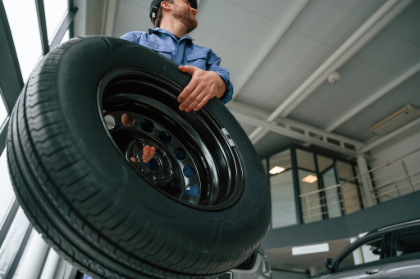INDEPENDENT DEALER
Based in the LowCountry Servicing Nationwide | (843) 368-2844
OUR BLOG
Spot the signs you need new tires before trouble hits! This post from Cappy's Premium Lubricants in Yemassee, SC, shares the must-know warnings for safer travel.

Why Tire Health Matters
Your tires are your car’s only contact with the road—and when they’re worn out, your safety is on the line. In South Carolina, where sudden storms and scorching summers push tires to their limits, driving on bad tread isn’t just risky—it’s dangerous.
Worn tires reduce traction, increase stopping distances, and make blowouts more likely. But how do you know when it’s time for a change? Watch for these 8 key signs you need new tires—before they put you in harm’s way.
Get AMSOIL’s high-performance lubricants from Cappy’s Premium Lubricants in Yemassee, SC. Call (843) 368-2844 today for personalized guidance! Plus, stock up on car care supplies at AMSOIL’s online store.
The Tread Is Worn Down
Tread depth isn’t just about traction—it’s about keeping you in control, especially when roads are wet. But over time, it wears down, and suddenly, your car starts sliding in the rain like it’s on ice skates.
Here’s an easy trick: Grab a penny and place it into the tread with Lincoln’s head upside down. If you can see his entire forehead, your tires are too worn—it’s time for new ones.
Don’t wait until they’re completely bald! Worn tires can be risky, especially with South Carolina’s sudden downpours. Stay safe and check them regularly.
Uneven Wear Patterns
If one side of your tire looks more worn than the other, something’s off. Maybe your wheels are out of alignment, or your tire pressure’s been low for too long. Either way, uneven wear means your car won’t handle as well—and you’ll need new tires sooner than you should.
To address the issue, rotate your tires every 5,000 to 7,000 miles, and if you notice uneven wear, get an alignment check.
You See Cracks or Bulges
Tires don’t last forever. Over time, heat, sunlight, and good old wear and tear turn sturdy rubber into a mess—especially in South Carolina’s scorching summers.
Cracks in the sidewall? That’s dry rot, weakening the tire’s structure. A bulge or bubble? That’s a weak spot ready to blow—especially if you hit a pothole or curb.
If your tires show these warning signs, don’t risk a blowout. Get them replaced—before it’s too late.
Your Car Vibrates at High Speeds
A little vibration is normal, but if your steering wheel feels like it’s got the jitters at highway speeds, something’s wrong. Maybe your tires are unbalanced, or there’s internal damage. Either way, that shaking isn’t just annoying—it’s a sign your tires are struggling and need replacement.
Low tire pressure can cost you money and compromise safety. The AMSOIL Tire Shaped Air Pressure Gauge gives you reliable, accurate readings every time. Order yours by calling Cappy’s Premium Lubricants in Yemassee, SC, at (843) 368-2844. Stock up on other essentials at AMSOIL’s online store today!
Your Tires Are Older Than Six Years
Even if the tread looks fine, tires degrade over time. The rubber hardens, losing flexibility and grip. Most manufacturers recommend replacing them after six years, no matter how much tread is left.
To check the age of your tires, look for the DOT code located on the sidewall; the last four digits indicate the week and year your tires were manufactured.
You’re Always Adding Air
If you fill up your tires every other week, you’ve got a slow leak. Maybe it’s a nail, a bad valve stem, or—worse—a cracked sidewall. Regardless of the cause, driving on under-inflated tires can lead to faster wear and tear, so it's crucial to keep an eye on your tire pressure. Make it a habit to check it at least once a month to ensure your safety on the road.
You’ve Had Multiple Repairs
One patch? Fine. Two? Maybe. But if your tire’s been patched repeatedly, its structure is weakened. At that point, replacement is the smarter move.
Don’t Wait Until It’s Too Late
Tires don’t fail all at once—they give you warnings first. If you notice any of these signs, don’t ignore them. Your safety (and your car’s performance) depends on good rubber.
So check your tires today. And while you’re at it, don’t forget that synthetic oil change—your engine deserves the same attention.